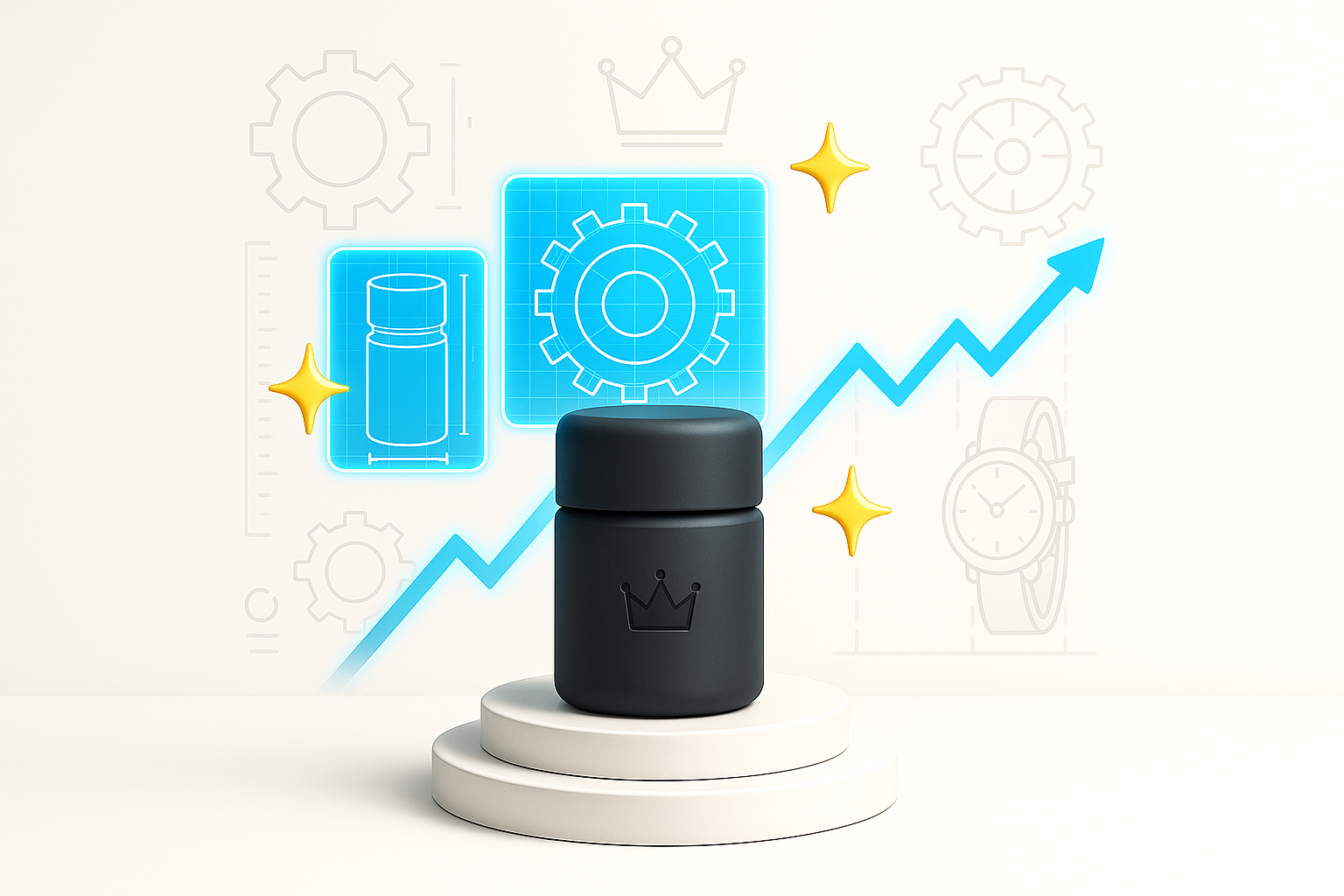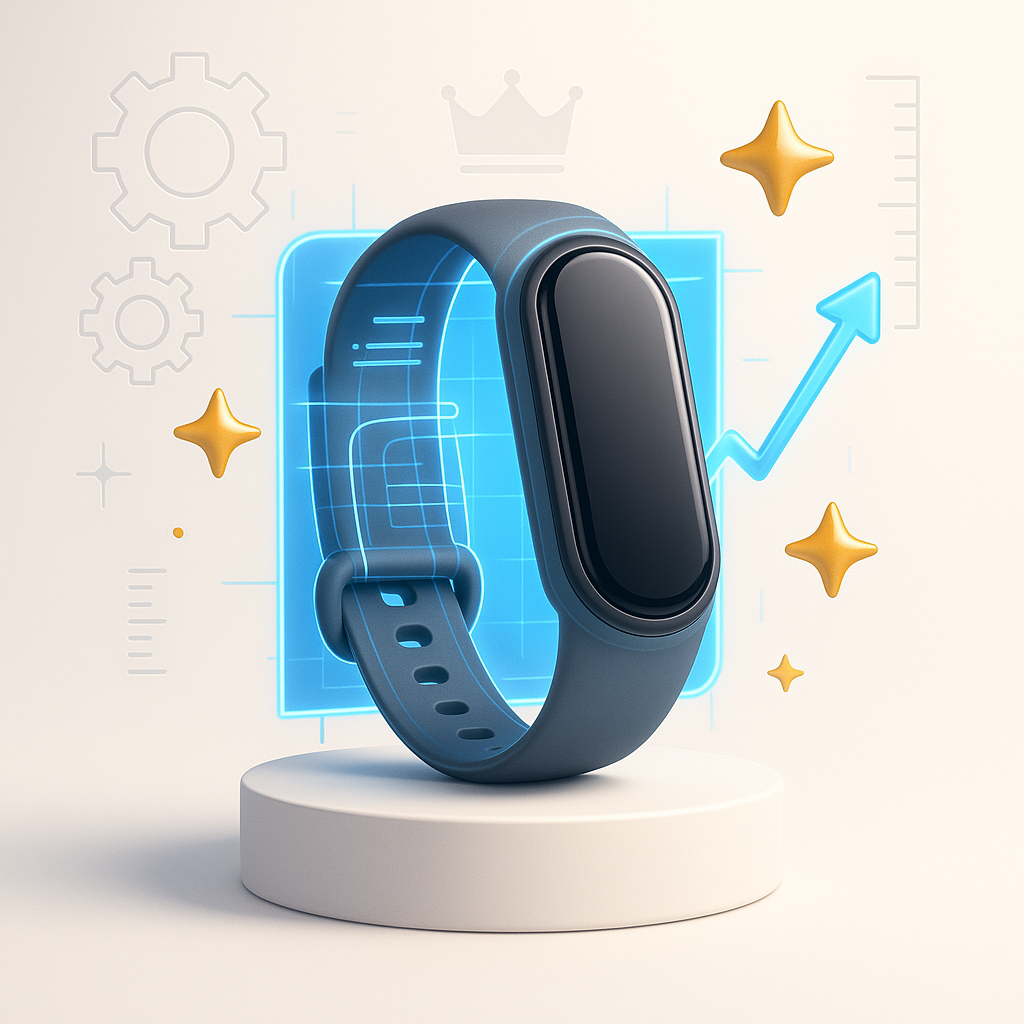How to Create a Category-Leading Product

In the SPLOW industries: Sports, Performance, Lifestyle, Outdoors, and Wellness, it's easy to get swept up in the aesthetics. Great branding, elevated packaging, polished storytelling, and a visually-popping Instagram grid can give the illusion of momentum. But the market doesn’t care about appearances. It rewards products that work.
That’s the brutal truth most founders eventually run into: you can’t brand your way out of a weak product. You can delay the reckoning, maybe even mask it for a while with hype or influencer backing, but at some point the experience has to hold up. In industries like fitness or wellness, where trust is fragile and word of mouth is your real distribution engine, what you deliver has to be undeniable. Not clever. Not trendy. Undeniable.
The most resilient businesses in this space address a pain point, elevate a daily ritual, or reimagine an experience so well that their customers can't imagine going back. That’s the new baseline. In a market full of noise and copycats, product excellence isn’t optional, it’s the foundation everything else depends on. This isn’t about chasing perfection. It’s about asking the hard questions early: What are we actually solving? Why does it matter? Then building with clarity, depth, and value.
In this guide, we’re not going to be focusing on trends or surface-level matters; we’ll be digging into what actually makes a product work. Not just for launch day, but for the long haul. You’ll learn what separates a nice idea from a real solution, how great products earn belief, and why evolving with your customer isn’t optional; it’s survival.
1. Solve Something Real
Every enduring product in SPLOW starts with a hard truth: you are not owed attention just because you care. Passion may fuel the journey, but it doesn’t guarantee product-market fit. The businesses that break through, and more importantly, hold ground, are the ones that solve a specific, pressing problem in a way that’s both effective and differentiated.
It sounds obvious. But many founders bypass this step. They fall in love with an idea, rush into branding, or get swept up in aesthetics before getting clear on the core utility. The result? Beautiful products no one urgently needs, and a business that feels harder than it should.
The market doesn’t respond to potential. It responds to usefulness. If you’re not solving something real, the rest is decoration.
Real Solutions are built on friction
The clearest signal that a problem is worth solving is friction. What are people trying to do that’s inefficient, frustrating, or incomplete? What are they manually hacking together because there’s no good option?
Peloton’s early rise is a case study in solving real friction. Before it, home workouts were either boring, low quality, or completely unstructured. You had to choose between joining an expensive studio or improvising with YouTube videos and DVDs. Peloton delivered something better: studio-grade cycling with real-time motivation and structure, right in your home. They removed the biggest pain points in fitness: commute, cost, inconsistency, and layered in community, gamification, and content.
But as the business scaled, their products started drifting away from the core problem it originally solved. Hardware iterations, expensive accessories, expanding content verticals, and attempts to become a full-blown media company diluted the focus. The friction wasn’t clear anymore, and the product no longer felt like a necessary solution; it instead felt like a luxury fitness ecosystem.
Add in the post-pandemic shift back to the gyms, plateauing demand, and operational bloat, the cracks started to appear fast. Peloton recognised this and have since refocused on the core friction they were built to solve: making consistent, quality fitness easier and more accessible. They’ve leaned into software, streamlined subscriptions, opened their content to more devices, and emphasised training programs that meet people where they are, not just on expensive hardware. It’s a shift from empire-building back to problem-solving.
Great products simplify decisions
Another way to identify real product opportunities is to look for decision fatigue; places where people aren’t stuck because they lack motivation, but because they’re overwhelmed by choice. When your product eliminates decision-making by becoming the obvious choice, you win.
Too much choice is a common problem in SPLOW industries: too many training plans, too many coaching models, too many apps, etc. For example, take the average runner who wants to put together a training plan. Do they follow a YouTube plan? Hire a coach? Download a spreadsheet? Sign up for a generic running app? Immediately you can see friction building, and the friction isn’t in taking action, it’s in figuring out which action to take. That’s decision fatigue. And it’s a real barrier to progress.
That’s where Runna comes in. Runna didn’t try to reinvent running. It didn’t chase novelty for the sake of it. Instead, it focused on a specific, high-friction moment in the runner’s journey: “I want to train for something, but I don’t know what to follow or if I’m doing it right.”
The app gives you a clean, structured plan based on your goals, experience level, and available time; whether you’re training for a 5K or a marathon. It adjusts dynamically, integrates with your wearables, and removes all the guesswork around pace, volume, and progression. You open the app, and your week is ready. One plan, one interface, one path forward. The value comes through removing complexity and neutralising decision fatigue. The team behind Runna know the struggle of training in isolation. They took that knowledge and translated it into a tool that feels like a coach in your pocket, without the overhead of managing spreadsheets or second-guessing your plan. Runna isn’t trying to be everything to everyone. It’s not a generic fitness tracker, nor is it a broad wellness platform. It’s a precise solution to a precise problem and that’s why it resonates.
In April 2025, this clarity and focus culminated in Runna's acquisition by Strava, the world's largest fitness community with over 150 million users. The deal, reportedly a multi-million-pound transaction, marked Strava's first UK acquisition and aimed to integrate Runna's personalised coaching into its platform, addressing a long-standing gap in structured training guidance for runners.
Now in the world of running, Runna is the obvious choice for running programmes, and being the obvious choice is a form of product excellence. Because clarity builds confidence. And confidence keeps people coming back.
Assumptions Feel Efficient, Until They Cost You!
Most products don’t fail because the team lacked passion. They fail because they built something slightly adjacent to what people actually need. Close, but not close enough to stick. And that gap between a founder’s idea and a customer’s reality, is usually created by assumptions.
Early-stage clarity comes from precision. That means understanding the real context your customer lives in; not just who they are, but what they’re navigating:
- Don’t think “health-conscious millennials,” instead think “runners training for their first race while juggling long work hours.”
- Don’t think “outdoor enthusiasts”, instead think “weekend hikers looking for gear that works without weighing them down or draining their bank account.”
The clearest early signals to take action show up in the way people work around a problem today. When someone says, “Right now I’m using this plus that, and then I just kind of figure it out…”, that is the signal. It means the need is there, but the solution isn’t. It means they’re tolerating friction, not because they want to, but because there’s no better alternative yet. That’s where your product lives.
Once you understand what people are trying to solve; not just theoretically, but experientially, everything else sharpens. Your messaging tightens, your roadmap looks clearer, and the product starts to feel inevitable, not experimental.
2. Build for Transformation, Not Just Function
Solving a problem gets you in the door. But solving it in a way that changes how people feel about themselves is what makes a product last.
In SPLOW industries, where identity and aspiration are baked into what people buy, transformation is the value. No one is buying protein powder just for protein. They’re buying momentum. They’re buying progress. They’re buying a version of themselves they haven’t met yet; and they believe your product will help them get there.
This is where functional products often fall short. They check boxes, hit features, follow best practices; but often leave people feeling exactly the same. There’s no shift. No identity gain. No reason to stay loyal once a competitor drops the price. The best products in SPLOW industries don’t just deliver outcomes, they create inflection points. They take customers from being casual to being committed. From unsure to structured. From drifting-in to dialled-in. That internal shift is the real product, and it’s what customers talk about when they say a brand “just gets them.”
Products That Deliver a Before and After
Look at Huel, for example. Functionally, it’s a powdered meal replacement. But its real value isn’t convenience or nutrition per se, it’s the promise of consistency. The emotional offer is: you’re the kind of person who doesn’t skip meals, doesn’t crash mid-afternoon, doesn’t make poor choices when things get busy. Huel sells functional fuel, but it also sells the identity of someone who is dialled-in, high-performing, and prepared.
That shift, from chaotic eating habits to structure, is a transformation. It’s why their customer base isn’t just buying one-off packets. They’re subscribing, they’re recommending, and they’re identifying with the product. Transformation gives products gravity. It creates stickiness, not through lock-ins or discounts, but through personal investment. When someone feels better, stronger, more disciplined, or more capable because of your product, they don’t just want it, they now need it.
Function Attracts. Transformation Retains.
Think about the first 30 days of using a product. Functional value gets people through that phase. But long-term adoption and loyalty comes from perceived change. Has my behaviour shifted? Am I making progress? Do I feel more like the person I want to be? That’s what makes a product referable. Not the UX. Not the design. Not even the price. It’s the sentence people say to their friend:
“Honestly, I finally feel like I know what I’m doing.”
“It helped me stay consistent for the first time ever.”
That’s the goal: build something that gets people to say that. Not because you coached them to say it, but because the product earned it.
A common trap founders fall into is projecting their own transformation onto the user. “This helped me, so it must help others the same way.” But people enter with different goals, constraints, and motivations. Your job isn’t to replicate your own journey, it’s to identify the specific version of transformation your customer is seeking, and design around that. Not just features that track progress, but experiences that create it. Interfaces that reward consistency, feedback that reinforces identity, and content that affirms they’re on the right path.
3. Make It Emotionally Sticky
A functional product gets used.
A transformative product gets remembered.
But a sticky product is the one people build into their identity.
Great products don’t just work, they land. They embed themselves in the mind, the body, and the routine. They become part of who someone is, not just what they use. This is emotional stickiness, and in SPLOW industries, emotional stickiness is one of the most reliable predictors of long-term traction. Functional value might get you adoption. Transformational value might get you love. But emotional stickiness is what creates attachment. It’s what keeps people from churning, even when there are cheaper alternatives or trendier options. It’s when your product carries meaning beyond utility.
Great Products Reflect Belief, Not Just Need
The most resilient products in SPLOW don’t just serve a function, they reflect a worldview. The user sees something of themselves, or who they want to be, in the product. It becomes an extension of their standards, their ambition, or their values.
You see it in the way WHOOP frames its experience. The data is valuable, sure. But the real win is what that data represents: ownership, accountability, discipline. The product isn’t just tracking strain or recovery. It’s saying, you’re someone who takes performance seriously. That’s identity-level messaging; and it’s embedded directly into the product experience. When a product starts reinforcing a belief someone already holds, or aspires to hold, it gains depth. It moves beyond transaction. And that’s when you start to see irrational loyalty, the kind that ignores price, forgives mistakes, and turns customers into advocates.
Emotional Stickiness Lives in the Details
This kind of resonance doesn’t come from a single brand moment; it’s cumulative. It’s how the slogan reinforces a belief, how the product details carry intention, how the onboarding flow sets a tone, and how the entire customer experience affirms the identity someone wants to embody.
Take Represent 247, the performance-focused line from Represent Clo. The message is clear right out of the gate — “247 is built for those who show up every day.” That’s not a tagline. It’s a standard. That tone is carried through everything: the muted, disciplined colour palette, the heavyweight fabric that holds shape through repeated wear, the streamlined cuts designed for function and pride. Even the campaign visuals; early morning runs, dimly lit gyms, real athletes in motion — all reinforce the same ethos: this is for people who train with purpose. When you open the parcel, it feels intentional. When you wear it, it says something. When you see others in it, there’s a silent nod; you’re built the same way. That’s what emotional stickiness looks like in the real world: a product that earns belief through details, and loyalty through identity.
You Can’t Manufacture Meaning. But You Can Design for It.
A mistake some brands make is trying to bolt on emotion after the fact. They write a lofty mission statement or sponsor athletes without first ensuring the product experience says something real. But if the product doesn’t feel like it was built with intention, that emotional layer doesn’t land and it reads like branding theatre. Instead, emotional stickiness comes from alignment between what the product does, how it does it, and why that matters to the people using it.
Start by asking:
- What does using this product signal to the user and to others?
- Does this product elevate or affirm something the user already believes in?
- Is there an emotional consequence to not using this anymore?
Sticky products don't force emotion. They create space for users to find their own meaning, and then they reinforce that meaning, again and again through the details.
4. Design for Adaptability
No matter how strong your product is today, if it doesn’t evolve, it dies.
SPLOW industries are shaped by constant motion: new science, shifting cultural priorities, viral routines, seasonality, and a consumer base that’s increasingly self-aware. What solves the problem now might feel irrelevant a year from now. That’s not a failure of the product, it’s just the pace of the world you’re building in. The most resilient products aren’t static. They’re systems designed to learn, flex, and improve; because in SPLOW industries, product excellence doesn’t mean building something that’s perfect, it means building something that’s ready to adapt.
Products That Can Flex Without Losing Focus
Adaptability isn’t about feature-chasing. It’s about knowing which signals matter, and adjusting with intention, not panic.
Take Eight Sleep, the smart mattress company. Their original value proposition was clear: better sleep through temperature control. However, as the brand matured, they didn’t get distracted by the broader “smart home” noise or try to reinvent themselves every quarter. They adapted within their lane. They layered in new features: sleep coaching, recovery tracking, HRV data and more. These all deepened their core promise: helping people optimise recovery through better sleep environments. Each evolution wasn’t a pivot. It was a progressive reinforcement of the same core truth that sleep is a performance edge.
This is adaptability done right; focused, relevant, and responsive. Not trying to be everything, just trying to be better at the thing you already do well.
Evolution Should Feel Native, Not Noisy
Poorly executed product updates feel like interruptions. Great ones feel like inevitabilities.
If you’re doing this well, your customers don’t even call it a “new feature.” They just think, “Of course it does this now.” It feels like the product is growing with them. The feedback loop isn’t just operational, it’s relational. You’re co-developing the experience alongside the people you serve. To do that well, you need great mechanisms for listening. Not just surveys or NPS popups, but true insight loops:
- What are power users asking for repeatedly?
- Where do people churn or drop off in your funnel?
- What hacks are your users building on top of your product?
Every friction point, workaround, or wishlist item is a breadcrumb. Follow enough of them, and the roadmap starts to write itself.
Don’t Build for “Forever.” Build for Momentum.
A common trap founders fall into is treating Version 1 like a final product; obsessing over every detail as if it’s set in stone. But great first versions aren’t meant to last. They’re meant to teach.
The best V1s are launchpads, not legacies. They’re how you start collecting real signal: What’s working? What’s being ignored? Where are people hacking their way to better outcomes? That feedback becomes the fuel for what’s next.
Look at how Levels approached their early product. They didn’t start with a polished consumer platform. They started with a basic prototype and a closed beta, inviting a small cohort to track their glucose data and give constant feedback. The early UX was clunky, the onboarding was manual, and there was no automation; but they gained a lot of insight. They saw where users were confused, where they dropped off, and what actually made the product feel valuable day-to-day. That learning cycle shaped the next versions, tighter insights, clearer visualisations, and better education around metabolic health. Today’s product looks nothing like that early version, but it exists because of it.
That’s adaptability in action. Not feature-chasing. Not “build fast and break things”, but listening deeply, iterating intentionally, and letting the real-world use case sharpen the product in ways theory never could.
5. Map Your Product System
Most early-stage products start with a strong idea. Some even solve a real problem. But the ones that scale, the ones that become operationally sound, strategically clear, and consistently referable, are the ones that are built like systems. A good idea can spark attention, a good system sustains it.
Mapping your product as a system means designing the product not just as a static deliverable, but as an interconnected system: the user journey, the feedback loops, the touch-points, the internal tooling, and the follow-through. In SPLOW industries, where the customer experience is often hybrid (part digital, part physical, part community), this becomes even more important. You’re not just managing features. You’re managing flows.
Every Great Product Is Built on Repeatable Loops
One of the clearest signs that a product is headed toward excellence is repeatability. Not just on the user side, but operationally:
- Is there a clear path from discovery → activation → retention?
- Are the internal workflows supporting the external promise?
- Can the team execute consistently without duct tape?
Take AG1 by Athletic Greens. On the surface, it’s a daily greens powder. But the system behind the product is what makes it powerful: clear onboarding sequences, habit-building emails, timed resupply, educational touch-points, and content that reinforces the core promise of daily optimisation. The product doesn’t just show up. It plugs into the customer’s life through designed repetition, reinforcing the habit, building trust, and reducing churn through rhythm, not force. That rhythm is what turns a product into a practice; and practices are sticky.
Systems Reduce Cognitive Load — for Everyone
When your product is built like a system, things become easier. Not just for the user, but for your team. There’s less guesswork. Fewer fire drills. Clearer dashboards. Cleaner onboarding. Fewer one-off asks. The product starts to become legible. Not just functional, but predictable. That’s when you know it’s working. Founders often assume “systems thinking” means complexity; something bloated, corporate, or unnecessary. But good systems do the opposite. They create clarity, reduce friction, and make smart decisions easier to repeat.
You shouldn’t be rebuilding your onboarding from scratch every few months. You shouldn’t be manually responding to the same ten product questions. You shouldn’t be hoping someone completes a workflow; you should know they will, because you’ve designed it that way.
Strong systems also protect your momentum. When core functions like FAQs, bug triage, experiment tracking, and onboarding are systemised, you’re not rebuilding from scratch every time the team grows or priorities shift. You’re not resetting, you’re iterating from a stable foundation. That’s the ultimate signal of system maturity: you can go faster without breaking things. Not because you’ve added more people, but because you’ve added more structure, the right kind of structure, the kind that scales with you, not against you.
6. Product as Promise
In SPLOW industries, great brands are built by consistently delivering on your promise. You can’t talk your way to trust. You have to earn it. Not once, but over and over, in small, compounding ways. That’s what product does when it’s working: it keeps the promise you made at the surface, deep into the experience.
In these industries, where trust is fragile and expectations are high, customers aren’t just buying what your product is, they’re buying into what it says it will do. And the real measure of excellence isn’t how bold the promise sounds on launch day; it’s how reliably the product upholds that promise, again and again. This is what separates hype from traction; because while marketing may set expectations, it’s the product that has to honour them.
Brand is the Residue of Delivery
Founders often think of “brand” as an exercise in storytelling. But in reality, brand is a memory: what people recall about your product after they’ve used it. It’s how they felt. It’s what they say when you’re not in the room; and nothing shapes that memory more than how well your product lives up to the expectations you set.
If you promise clarity but deliver confusion, that mismatch becomes your reputation. If you speak of community but vanish after onboarding, the absence is what people remember. But if you say, “We’ll help you train smarter,” and the product delivers on that, not once, but week after week, then trust is earned and reinforced. Look at Garmin. It doesn’t have the flash of newer fitness wearables. It doesn’t dominate TikTok or lead with aesthetics. But for serious outdoor athletes, Garmin means one thing: reliability. When you’re halfway up a mountain or pacing through an ultra-marathon, Garmin isn’t promising lifestyle vibes; it’s delivering accurate data, long battery life, and rugged tools that often work without fail; that’s why it earns loyalty. The product and the promise are the same thing.
Clarity on Promise = Clarity on Priorities
When you understand the promise your product exists to keep, your priorities sharpen. You make better decisions, you move faster, you know what to double down on, and you know what to ignore.
- If your promise is simplicity, every feature should reduce friction, not add it.
- If your promise is performance, everything from hardware to onboarding should scream precision and progress.
- If your promise is trust, you don’t cut corners on quality or support.
Without that clarity, teams chase noise. They build for novelty. They add layers because someone on the team saw it in another product; that’s not how standout products are made. The strongest teams build in alignment. Every iteration, every message, every workflow is tuned to reinforce the same core belief: this works, and it’s for you.
Delivery Creates Brand. Not the Other Way Around.
It’s tempting to think you need to “build the brand” before launch. But in reality, your brand is built through what you consistently deliver. You don’t need to manufacture mystique, craft a manifesto, or chase virality. Just focus on becoming known for one thing and doing that thing better than anyone else.
That’s how companies like Therabody earned their reputation. They weren’t the first brand to sell massage guns, and they certainly weren’t the cheapest. But they zeroed in on one core promise: recovery, elevated. Their product, packaging, content, retail presence, and pro partnerships all worked together to make that promise feel premium and trusted. Over time, people didn’t just want a massage gun. They wanted a Theragun. That’s not brand as storytelling. That’s brand as delivery, multiplied.
7. Build What Earns Belief
Every founder wants belief; from users, investors, teammates, and often, from themselves. But belief doesn’t come from vision decks or launch hype. In SPLOW industries, belief is earned through the product. Not once. Not loudly. But repeatedly, and with care.
You earn belief when your product makes people feel better; not just physically, but psychologically; when it fits seamlessly into their lives and starts pulling its weight without being asked, and when it keeps its promises in quiet, consistent ways. It doesn’t matter how loud your brand is, how clever your copy is, or how much PR you generate ; if the product doesn’t hold up, the story doesn’t stick, and belief is not earned.
And that’s the paradox most early teams forget: trust isn’t built at launch. It’s built in the days after. When the influencer campaign fades, when the first real bug surfaces, when a user forgets about you; but your product quietly reminds them why they came in the first place.
The Product Is the Brand
People often treat brand and product as separate disciplines; the art and the engine. But in truth, your product is the loudest expression of your brand. Not your logo. Not your aesthetic. Not your brand book. It’s the thing people touch, use, and return to. It’s the conversation happening in the background when you're not in the room. If the experience is thoughtful, reliable, and valuable; your brand becomes synonymous with quality. If it’s clunky, inconsistent, or forgettable; no amount of storytelling can save it. In the end, your brand isn’t what you say. It’s what your product teaches people to expect.
You Don’t Need to Be Perfect. You Need to Be Intentional.
Product excellence doesn’t mean polishing every pixel or building a feature-rich monster; it means being deliberate and solving one meaningful thing with real depth. Most importantly, it means making decisions that compound; choices that get better the more someone uses what you’ve built. When you design with that level of care, people feel it. And when they feel it, they trust you. Not just with a purchase, but with a piece of their routine. Their time. Their identity. That’s the highest compliment a product can receive.
The Work Doesn’t End at Product Market Fit. That’s Where It Begins.
If you’ve read this far, you likely care deeply about what you're building. And that’s a good start, but it’s not the finish line. Getting to product-market fit is not the end of the road. It’s the point at which the real responsibility begins. Because now, people are counting on you. They’ve bought in. They’re showing up. And your job isn’t just to keep them; it’s to keep making their lives better.
That’s what product excellence really is. Not polish. Not scale. Not hype. It’s earning belief, one interaction at a time; and refusing to let that belief go to waste.
Get the latest news, blogs and resources direct to your inbox!





